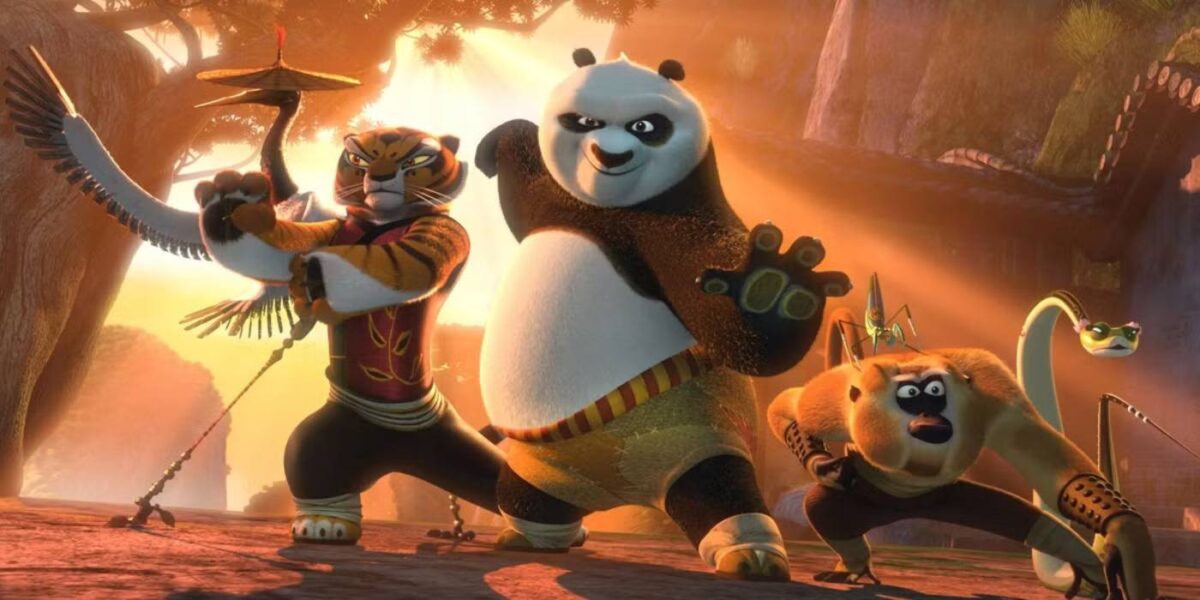An unlikely warrior with a belly full of noodles and zero discipline stumbled into a dojo where fate hit harder than fists. DreamWorks Animation balanced slapstick energy with spiritual themes in a series that integrated kung fu-inspired action sequences with humor and narrative explorations of personal growth. The series featured villains forged with dramatic weight and settings characterized by detailed visual compositions rooted in traditional Chinese cultural motifs.
The studio launched the first film in 2008, letting Jack Black’s voice bounce between chaos and chi. The franchise follows the unlikely evolution of Po Ping, a clumsy, overeager panda chosen by prophecy to become the Dragon Warrior. Set in a stylized, wuxia-influenced version of ancient China populated by anthropomorphic animals, the films explore his transformation into a kung fu master under the guidance of Master Shifu and the Furious Five.
Jack Black leads the voice cast, which includes Angelina Jolie, Lucy Liu, Jackie Chan, Seth Rogen, David Cross, and Dustin Hoffman, all of whom were present from the beginning of the series. The franchise features four theatrical features, several short-form productions, and three animated television series, all released under different distributors, including Paramount Pictures, 20th Century Fox, and Universal Pictures.
On the television side, episodes have aired on Nickelodeon and Nicktoons, with newer content also available on Amazon Prime and Netflix. The four theatrical films have pulled in over $2 billion worldwide, making it the seventh highest-grossing animated film franchise in cinematic history. Let’s take a look at the Kung Fu Panda movies, ranked by their box office muscle.
4 Kung Fu Panda 3 (2016)
 Courtesy of Universal Pictures
Courtesy of Universal Pictures
Global Box Office, Kung Fu Panda 3 — $521,170,825
The challenge of completing a trilogy has humbled many franchises, but Kung Fu Panda 3 was recognized for preserving the strengths of its predecessors. It opened new narrative ground, following Kai, an ancient fighter with ties to Master Oogway, who slips from the spirit realm to rob the living of their chi. Po’s long-awaited reunion with Li Shan leads him to a hidden panda village, where the urgency of survival overshadows the joy of being reunited with his family.
The film widened the mythology of the franchise, juxtaposing the mystical spirit realm’s luminous imagery against the playful environment of the panda village. Animation highlighted vibrant palettes and intricately staged battles, while action sequences carried the series’ trademark choreography rooted in martial arts spectacle. Po’s relationship with Li Shan gave the narrative a multigenerational focus, balancing comedy with themes of identity and lineage.
Produced as a collaboration between DreamWorks Animation and Oriental DreamWorks, Kung Fu Panda 3 was the first film in the series created for release in both English and Mandarin. The Mandarin version featured separately animated mouth movements synced to Chinese dialogue. Kung Fu Panda 3 grossed $143.5 million in the United States and Canada, and $377.6 million in other territories, for a global total of $521.2 million against a $145 million budget. According to Deadline Hollywood, the film generated a net profit of $80.65 million, making it one of the most profitable releases of 2016.
|
Estimated Budget |
$145,000,000 |
|---|---|
|
Opening Weekend (Domestic) |
$41,282,042 |
|
Box Office (Domestic) |
$143,528,619 |
|
Box Office (International) |
$377,642,206 |
|
Box Office (Total) |
$521,170,825 |
3 Kung Fu Panda 4 (2024)
 Courtesy of Universal Pictures
Courtesy of Universal Pictures
Global Box Office, Kung Fu Panda 4 — $547,946,428
Eight years after Po’s previous adventure, the franchise returned with a new installment focusing on themes of transition and legacy. The story followed Po as he prepares to pass the mantle of Dragon Warrior while confronting The Chameleon, a sorceress capable of mimicking the appearance and kung fu abilities of previous villains.
Viola Davis voiced the antagonist, and Ian McShane reprised his role as Tai Lung in a cameo sequence that pulled directly from the series’ earliest conflicts. While the story welcomed new faces, the Furious Five were largely absent, appearing only in non-speaking roles. The film explored the crossroads of personal identity and succession, with Po standing as the conduit between legacy and destiny. The animation highlighted the clash between the spectral shifts of The Chameleon and the vivid landscapes of the Valley of Peace.
Kung Fu Panda 4 took in $193.6 million in North America and $354.4 million in international markets, for a worldwide gross of $547.9 million against a production cost of $85 million. With production costs and box office returns accounted for, Deadline Hollywood calculated a $178 million net profit, making the film the eighth-most profitable blockbuster of 2024.
|
Estimated Budget |
$85,000,000 |
|---|---|
|
Opening Weekend (Domestic) |
$57,989,905 |
|
Box Office (Domestic) |
$193,590,620 |
|
Box Office (International) |
$354,355,808 |
|
Box Office (Total) |
$547,946,428 |
2 Kung Fu Panda (2008)
 Courtesy of Universal Pictures
Courtesy of Universal Pictures
Global Box Office, Kung Fu Panda — $632,384,787
Every franchise begins with a first step, and Kung Fu Panda did so with a tale that married comic spirit, kung fu brilliance, and emotional weight. The film followed Po, an overweight noodle shop worker and kung fu enthusiast, who finds himself unexpectedly chosen as the Dragon Warrior. Training under Master Shifu, Po’s clumsy nature gave way to ingenuity as he embraced his own style of kung fu to confront Tai Lung, a powerful antagonist voiced by Ian McShane.
The narrative emphasized themes of persistence, individuality, and inner strength in Po’s character arc. The fight sequences incorporated choreography inspired by traditional martial arts, adapted into animation that highlighted speed and accuracy. Jack Black’s voice performance defined Po with exuberance, while Dustin Hoffman voiced Master Shifu, and Ian McShane provided menace as Tai Lung. Angelina Jolie, Jackie Chan, Lucy Liu, Seth Rogen, and David Cross rounded out the ensemble that reprised their roles in subsequent films.
The film wove humor and martial arts spectacle with animation steeped in Chinese artistic motifs. Undercurrents of tolerance and community deepened the narrative, as Tai Lung’s shadow became a touchstone for villains that followed. Kung Fu Panda grossed $216 million in the United States and Canada and $416.3 million internationally, for a worldwide total of $632 million. It was the highest-grossing non-Shrek film from DreamWorks Animation at the domestic box office until surpassed by How to Train Your Dragon in 2010.
|
Estimated Budget |
$130,000,000 |
|---|---|
|
Opening Weekend (Domestic) |
$60,239,130 |
|
Box Office (Domestic) |
$216,064,546 |
|
Box Office (International) |
$416,311,606 |
|
Box Office (Total) |
$632,384,787 |
1 Kung Fu Panda 2 (2011)
 Courtesy of Universal Pictures
Courtesy of Universal Pictures
Global Box Office, Kung Fu Panda 2 — $665,692,281
Sequels are the make-or-break test of a franchise, and Po’s 2011 return with Master Shifu and the Furious Five arrived under towering expectations. The film followed Po as he confronted Lord Shen, a peacock warlord who wielded gunpowder weapons and was foretold to be defeated by a black-and-white warrior. Po’s discovery of his tragic past and the near-eradication of pandas gave the story an emotional weight that distinguished it from its predecessor.
The sequel paired its martial arts spectacle with themes of grief and resilience, as Po’s battles with Shen mirrored the villain’s inability to accept destiny. Shen, voiced by Gary Oldman, is one of DreamWorks Animation’s best villains, pairing elegance with menace in ways that challenged Po physically and emotionally. The contrast between Po’s exuberant energy and Shen’s ruthlessness created a dynamic that fueled the sequel’s intensity.
Animation emphasized striking visuals, with elaborate action sequences designed to highlight the destructive force of Shen’s weapons and the fluidity of martial arts combat. Thematically, the film centered on how individuals process pain and loss, contrasting Po’s growth with Shen’s descent. Kung Fu Panda 2 grossed $165.2 million in North America, and $500.4 million in other territories, for a worldwide total of $665.6 million, making it the highest-grossing Kung Fu Panda movie to date.
|
Estimated Budget |
$150,000,000 |
|---|---|
|
Opening Weekend (Domestic) |
$47,656,302 |
|
Box Office (Domestic) |
$165,249,063 |
|
Box Office (International) |
$500,443,218 |
|
Box Office (Total) |
$665,692,281 |















































































































